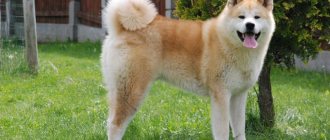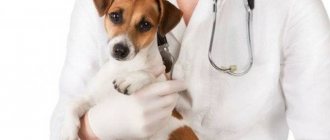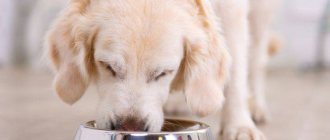Preparation
Regardless of where you plan to keep an adult dog - in an apartment/house or on the street, you should take a puppy into the house for the first time. There you will get used to each other, learn understanding and good manners. Also, the puppy should be protected from contact with the street until the necessary primary vaccination is completed and the baby’s immunity is strengthened.
Security and Protection
When the puppy first appears, he will begin to explore and taste everything, so remove everything unnecessary from his reach.
Shoes, wires, children's toys - all this can not only be damaged by the puppy, but can also harm his health
Be sure to remove carpets from the floor if you have them - at first the puppy will do his business wherever he has to, before you teach him to do it where he is supposed to.
What does a puppy need in the house?
From the first day of being in a new home, the puppy will need certain conditions and objects for full development, growth and training to comply with established rules.
Own place
Photo: Donika Sadiku A dog, like any animal, needs its own “corner” where it will feel safe.
Immediately determine where the pet will have his place and, if possible, equip it as comfortably as possible. The place should not be located in a passageway, near a door or in a draft. It should be both secluded and have a good view from it (for example, the corner of a room). At a minimum, the puppy should have its own bed (preferably with sides), it is better if it is a cozy house like a kennel with soft bedding. It is important that no one invades the puppy’s territory, so that the pet understands and knows that there is only his place, where he is comfortable and calm.
You can also equip your puppy with a fenced-off space in a place convenient for you, where he can run freely. It will be possible to place his bowls and toilet there.
Bowls for food and drink
The puppy will need separate dishes for food and water. You should choose bowls depending on the breed of your pet (for example, for breeds of medium size and above, you should use a stand for bowls with adjustable height for the correct posture of the dog; for long-eared breeds, specially shaped bowls that prevent long ears from getting inside; for breeds with flat faces Do not use deep dishes, as it will be difficult for them to reach the contents).
Dishes for food and feed should be placed away from the area reserved for the toilet; hygiene rules should be taught immediately.
Feed
A dog needs its own food, prepared especially for it according to a balanced diet. This is especially important during puppyhood. And remember that you cannot feed your pet the same thing that you eat yourself - a number of foods that we eat are contraindicated for dogs.
It is best to feed the new inhabitant of your home the same thing that the previous owners fed him.
If for some reason you find the puppy’s previous diet unacceptable, then you should not switch your dog to a new one immediately, but later and gradually, in order to avoid unnecessary stress and possible intestinal upset.
If you don’t know what the puppy ate before it came to your house, then for feeding you can use boiled chicken and sea fish without bones, low-fat cottage cheese, and other fermented milk products. In the future, you can gradually switch to good quality dry food.
If your puppy is too small and cannot yet eat on his own, then a bitch milk replacer will help you in this case. You can purchase it at a veterinary pharmacy, as well as a bottle for its use.
Toilet space
From the very first day, you will need to strictly determine the place where the puppy can relieve himself. It is better if this place is in a fairly secluded place. There, place a diaper (disposable or a special reusable one that can be washed) or a tray (the main thing is that its sides are not too high for the baby).
Be patient, the puppy will not immediately figure out where he should go to the toilet, and you should not scold him when he does it anywhere. As soon as you notice that the puppy has sat down to relieve itself, immediately transfer it to the tray (on the diaper). When the puppy goes to the toilet in the right place, praise him, let him immediately begin to understand that this is good.
Toys
Photo: Chris Jimenez Toys (balls, rubber bones and rings, special ropes) are very important for a puppy - they help him develop, protect your things from possible gnawing, and are simply a remedy for boredom.
An important requirement for toys is that they be made from safe materials with a dense consistency so that the puppy cannot bite off pieces of them with his sharp teeth. It is also worth choosing a toy for your pet of a suitable size so that he can easily grab it with his teeth and carry it.
It is best for your puppy to purchase special toys designed specifically for dogs; they are sold in pet stores. Never let your puppy play with soft toys, unnecessary shoes or other things that are not intended for this purpose. Otherwise, you can harm your pet's health, and in addition, you will instill in him the bad habit of gnawing on foreign things.
First aid kit
It is best to visit a veterinarian as soon as you have adopted your puppy so that he can assess the general health of the pet and give general advice on care and feeding. He will also give advice on what medications you should have at home and why.
However, in any case, you will need bandages, cotton wool, antiseptics (chlorhexidine, levomekol), as well as drugs used for intestinal disorders and poisoning (smecta, activated carbon, etc.).
In the future you will need
In the first days in a new home, the following items will be superfluous, but as your pet grows you will need them:
- ammunition - a collar and leash or harness will be useful for training and walking your pet
- grooming products - dog shampoos, combs, nail clippers, etc. will be needed to keep your pet neat and aesthetically pleasing.
Even if you received a puppy with dirty fur or parasites, do not rush to bathe him on the first day - this will become additional stress, let the pet get comfortable and get used to you a little.
What will be required of you
Caring for a puppy is not easy, especially if you have just adopted one. He needs a lot of attention and care, so if you are planning to adopt a puppy, then plan to spend time with the puppy for the first time (for example, during a long weekend or vacation) until he gets a little used to being alone.
When a small puppy appears in the house, you should be careful and attentive in your usual actions, so as not to accidentally injure the pet (step on the paws or tail, hit with a closed door, etc.)
Keep in mind that, most likely, the puppy will whine and act restless the first night (and possibly the next few), because he is in a new place and for the first time alone, away from his mother and brothers and sisters.
What to feed your pet? Healthy food for dogs
So, we come to the most important thing - how to feed a dog? An adult should be fed twice a day. The little puppy is five or six. What should be included in the diet? Raw meat. This is a very important product in the diet of dogs of all ages. For a one-month-old puppy, the daily requirement is fifty grams of finely chopped beef. You should not use minced meat, as it passes very quickly through the dog’s stomach and does not have time to be digested. In addition to beef, the dog can eat chicken and rabbit. Bird necks can also be given. The bones in them do not pose a danger to the digestive system of dogs.
You can give your pet offal. These include: liver, kidneys, stomach, lungs and others. Note that raw beef liver is rich in vitamins. Just before giving it to the dog, the offal should be doused with boiling water. It is better not to give the spleen. Beef kidneys can be given in small quantities to dogs, especially those who are prone to eating excrement. In addition, such food is rich in enzymes and microelements.
Fish can be given to dogs, but only sea fish (without bones) and no more than three times a week. Boiled eggs (no more than two per week) and low-fat fermented milk products (cottage cheese, kefir, etc.) are also added to the diet.
Dogs can be fed buckwheat and rice porridge. It is better to steam oatmeal with boiling water rather than boil it. Pearl barley porridge should not be given to dogs; dogs cannot digest it. Vegetables, fruits and greens in small quantities will also be useful.
You can add sunflower oil to the porridge (one or two tablespoons, depending on the volume of food). You can also feed your dog dry food. But they must be premium or super-premium. The animal must have fresh water available. It is also worth giving vitamins periodically, for example during the molting period.
We pick up a puppy from the breeder
If you are taking a puppy from a breeder of the breed, then it will be useful for you to find out some details about keeping the pet, and in the future you can always turn to the breeder for advice, because he has experience in raising dogs of this breed.
What you need to know
Ask the breeder about the character traits of your puppy; as a rule, they have time to prove themselves by the age when they are looking for a new home.
Photo: Cole Young It is also important to find out from the previous owner the specifics of the pet’s feeding diet and in the first days of being in the new home you should stick to it.
Information about the puppy’s previous living conditions will be useful; it will make it possible to minimize stress by creating familiar living conditions for him.
It is important to clarify what veterinary procedures were performed on the puppy: deworming, necessary vaccinations, etc.
What to take with your puppy
When picking up a puppy from the breeder, do not forget to take the pet’s veterinary passport, which should indicate the veterinary treatments performed, as well as documents confirming the pedigree (puppy card or birth certificate).
It would not be a bad idea to ask the previous owner of the puppy for some thing or toy that was close to the mother and offspring and absorbed their odors. They will remind the puppy of home and will allow him not to feel lonely; these things will be especially useful on the first night.
How to transport a puppy
Soft carrier It is best to take the puppy home in a soft carrier, but so that his muzzle is outward and he can see everything around him.
If the baby is scared, then hold him close to you, this will calm him down. Keep in mind that on the way he may wet himself or get seasick, so agree with the breeder in advance about the time and ask not to feed the puppy before the trip, and also take water, napkins and bags with you.
The appearance of a puppy in the house
It is better to take the puppy in the first half of the day so that he has more time to settle in and get used to his new home before his first night in a new place.
Getting to know the house and its inhabitants
Photo: Paul Wordingham The first appearance of a puppy in the house usually causes delight among the household, but the puppy can be frightened by sudden excessive attention, so everyone should behave with restraint and get to know each other gradually.
If you have children, then explain to them how to properly pick up a puppy (carefully but firmly, with two hands: one under the front legs and chest, the other under the butt and hind legs) and how to behave with him (not excessively disturb him, including when he is sleeping, and he will sleep a lot).
The puppy should be “introduced” to other pets in the house carefully and gradually. Let them sniff each other, but carefully monitor their behavior to avoid the consequences of possible aggression.
How to house train a puppy
First of all, you need to let the puppy satisfy his curiosity and explore his new home on his own. If at this time he wants to go to the toilet, then initially you should not take him to the designated place, since he is not yet familiar with everything.
When the puppy's curiosity has been quenched a little, you can familiarize him with his key habitats - the “bedroom”, “kitchen” and toilet. Feed your baby from his new bowls and let him gradually get used to them. Soon after feeding, he will want to go to the toilet, so watch him closely and when you notice the signs, transfer the puppy to the litter box (or diaper). After the toilet, take your pet to his secluded place to sleep; first put in the bed the thing that you took from his previous home.
Video about a golden retriever puppy's first day in a new home
You need to decide in advance whether you plan to allow your pet to climb onto the bed in the future. If so, you can take the puppy to the bed from the first day, but do not leave him there unattended (he may fall) and do not allow him to jump off on his own (he may get injured).
Puppy "cries" at night
Photo: Allie Tissot On the first night, and possibly the next few, your baby may whine and act restless - this is a completely natural reaction from a puppy. However, if this behavior drags on or appears not only at night, then you should consult a veterinarian; perhaps the baby is in pain.
Why does the puppy whine?
As a rule, during the first nights the puppy greatly misses his mother and other puppies from the litter, his usual surroundings, so he cannot sleep or sleeps restlessly, whines and looks for someone to cuddle with. You shouldn’t scold your baby for this, give him time to adapt and get used to you and the new home.
What to do if your puppy whines at night
The baby whines the first night and it torments your soul, but you need to be firm - you cannot respond to his every squeak, otherwise this behavior will not stop. Here are some tips to help reduce your puppy's first night discomfort:
- This is where something with a “native” smell taken from the previous home will be most useful - put it on the baby’s bed, let it remind him of home
- You can also put a warm (but not hot) heating pad wrapped in soft fabric in your pet’s “bed” - the baby is used to having the warm body of his mother and siblings next to him, so he will be more comfortable with a heating pad
- Before going to bed, feed the puppy; it is always difficult to sleep on an empty stomach, but do not overfeed or give unfamiliar food - this can lead to discomfort and pain in the abdomen or even intestinal upset
- put a “chew” toy in the bed or nearby - if the dog is not sleeping because he simply doesn’t want to sleep, then the toy will help distract him
- At night, it is advisable to avoid sharp sounds in the house, this can frighten the baby and make him whine in fear.
What else needs to be done
When the priority chores are over, it's time to do other mandatory things.
Give the puppy a name
Photo: ChikoBirdyhof Come up with a nickname for the dog, even if the name has already been assigned in the pedigree, you will still most likely need to decide on a more sonorous derivative nickname (or a simpler version of it). Gradually accustom the puppy to its nickname, literally from the first day in your home. Until the puppy understands that the nickname refers to him, the nickname itself should only be pronounced in a calm and soft tone, and after getting used to it, you can make accents with your voice (for example, call him strictly if he is misbehaving).
Visit a veterinary clinic or call a veterinarian at home
It would not hurt for your new pet (and if you adopted a puppy from the street, it is mandatory) to be examined by a veterinarian for a general assessment of its health and development. He will also advise you on the necessary veterinary treatments and their timing, and carry them out if necessary.
If your puppy does not yet have a veterinary passport, then your veterinarian will be able to get it properly issued right away.
Contact the kennel club
If you have a purebred puppy and the breeders have given you his metric (puppy card), then you should contact the kennel club to formalize the pedigree and register with the club for the purpose of further participation in exhibitions.
Myths
The average person, who has not fully immersed himself and does not know all the intricacies of the dog breeding business, has several persistent myths that make him believe that there is nothing complicated about it; it is enough to have a purebred pet and the opportunity to breed it with a suitable male. However, this is not quite true:
- Even a single birth of a domestic dog is a large financial investment , wasted time and nerves with no guaranteed successful outcome. Moreover, without conducting sufficient veterinary research or in the event of an unfortunate combination of circumstances, there is a risk of significantly deteriorating the animal’s health.
- A dog with documents is not the basis for creating a business . After all, this is not enough to get quoted offspring. It is necessary to constantly keep in touch with nurseries, participate in exhibitions and regularly occupy prominent places at them. Regularly undergo examination by veterinarians, get all vaccinations and treatment against parasites on time. Undergo additional expensive examinations to identify hidden diseases that are inherited.
- Puppies are easy and don’t require much effort. Yes, the mother dog copes on her own in the first weeks. However, it requires constant monitoring. And after the puppies begin to actively move around the house, a large amount of cleaning and feeding is also added. Considering that there may be two, or perhaps eight, kids, this is not such an easy task. And without careful care, weaker babies may die.
Also, do not forget that finding a buyer is also not as easy as it seems at first glance. Yes, the nursery can help with some things, but basically you will have to advertise on your own, advertise the product and look for responsible buyers.
And some more useful tips
If you are just about to get a puppy, then the following tips will help you a little. You can learn more about how to choose the right puppy from our article.
At what age is it better to adopt a puppy?
Photo: Dineshraj Goomany It is undesirable to separate the puppy from the litter too early and transfer it to a new home - this is unnecessary stress for the baby, and it also adds certain difficulties to care.
At this age, puppies are rarely able to eat on their own, they do not tolerate separation from their home nest well, and it is good for the immune system to stay with their mother longer. The preferred age at which to adopt a puppy is from two to three months - by this period they are already quite strong, confidently feed on their own and, as a rule, they have already received the necessary primary vaccination.
What time of year should you get a dog?
Dogs usually give birth to puppies in the spring or fall. It is preferable to take a puppy from a spring litter, so he will have more time to get stronger and begin to safely go outside, where he will encounter adverse weather conditions at a more suitable age.
Don’t be afraid of responsibility when you suddenly have a defenseless creature in your hands. You can handle everything, the main thing is to prepare properly and be patient. Yes, a dog requires a lot of time, but this is rewarded with its boundless love and devotion.
What gender should I choose for my pet? Peculiarities of behavior of males and females
If you decide to get a dog, then you need to know how to choose one. More on this later in the article. It is important to take into account many nuances: age, breed and gender. It’s not enough to say: “I want to get a dog.” You need to decide what gender you want the animal. This affects the characteristics of care. Both genders have their own pros and cons in character.
Dog experts say that bitches are more emotionally unprotected. They are closer to humans than males. Girls are more trainable and more flexible. A bitch is attracted to a dog about twice a year.
If we talk about the disadvantages of girls, they are estrus and unplanned pregnancy. Often bitches have a false pregnancy, as well as various complications against this background. If you do not want to breed puppies, you should consider spaying the female dog. There is no need to talk further about increased care and attention during the period of bearing babies. It's obvious.
Males are energetic, assertive, reckless. They also experience uncontrollable joy. We are ready to delight our owners with positive emotions every day. Increased activity and the absence of difficulties associated with pregnancy are the main positive qualities of male dogs.
Now let's talk about the disadvantages. The first and main thing is that male dogs have an increased interest in representatives of the opposite sex all year round. They have an expressed desire to dominate. They often strive to take a leading position in the family. Particular attention should be paid when raising a service breed male. With the right approach, animals show excellent results.











